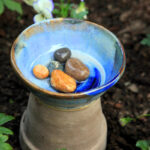
BEE FOUNTAINS
Just like all creatures, pollinators need fresh, clean water to live. An ideal water source for pollinators is one that is still or slow-moving, and has a place for the pollinator to land (such as a rock, leaf, or log), so that they will not be at risk of drowning while drinking.

Remember to put rocks in your bee fountain so the visiting pollinators have a safe place to land!
Materials:
- Shallow dish (jar lids are great!)
- Rocks, decorative stones, or marbles (optional)
Directions:
- Grab a shallow dish that can stay outdoors (the lid of a pickle jar or Bela’s Bees Raw Honey jar works perfectly!)
- Fill your dish or lid with 1cm of water.
- Add 1 or 2 rocks, decorative stones, or marbles to your dish or lid, so that the visiting pollinators have a safe place to land.
- Place your dish or lid in a shady spot (so that the water will not evaporate too quickly). Choose a spot that is also secluded so that your pollinators will not be disturbed by people or potential predators while drinking. You may also wish to find a spot that is close to a pollinator food source.
- Check on your bee fountain every day or so, refilling it as necessary.
Go to PAGE 5 to read about the rare Rusty Patched Bumble Bee!

